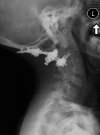Bone morphogenetic protein in pediatric spine fusion surgery
- PMID: 27683689
- PMCID: PMC5039831
- DOI: 10.21037/jss.2016.01.06
Bone morphogenetic protein in pediatric spine fusion surgery
Abstract
Background: There is a paucity of literature describing the use of bone graft substitutes to achieve fusion in the pediatric spine. Outcomes and complications involving the off-label use of bone morphogenetic protein 2 (BMP-2) in the pediatric spine are not clearly defined. The purpose of this study is to review the existing literature with respect to reported outcomes and complications involving the use of low-dose BMP-2 in pediatric patients.
Methods: A Medline and PubMed literature search was conducted using the words bone morphogenetic protein, BMP, rh-BMP-2, bone graft substitutes, and pediatric spine.
Results: To date, there are few published reports on this topic. Complications and appropriate BMP-2 dosage application in the pediatric spine remain unknown.
Conclusions: This report describes the potential for BMP-2 to achieve successful arthrodesis of the spine in pediatric patients. Usage should be judicious as complications and long-term outcomes of pediatric BMP-2 usage remain undefined in the existing literature.
Keywords: Pediatric; bone morphogenetic protein (BMP); spine fusion.
Conflict of interest statement
The authors have no conflicts of interest to declare.
Figures
References
-
- Haft GF. Is off-label use of BMP in pediatric spine surgery now a standard of care? Commentary on an article by Amit Jain, MD, et al.: "Factors associated with use of bone morphogenetic protein during pediatric spinal fusion surgery. an analysis of 4817 patients". J Bone Joint Surg Am 2013;95:e103 1-2. - PubMed
Publication types
LinkOut - more resources
Full Text Sources
Other Literature Sources

